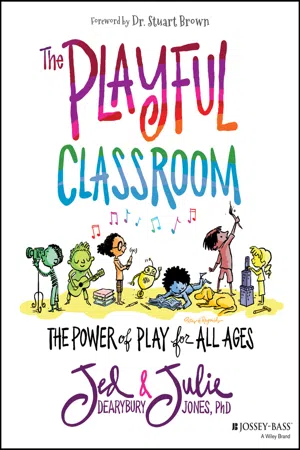
The Playful Classroom
The Power of Play for All Ages
Jed Dearybury, Julie P. Jones
- English
- ePUB (mobile friendly)
- Available on iOS & Android
The Playful Classroom
The Power of Play for All Ages
Jed Dearybury, Julie P. Jones
About This Book
Shows teachers how and why they should bring play into the classroom to make learning meaningful, relevant, and fun.
Research studies show that all students—young and old, rich and poor, urban and rural—benefit immensely from classrooms filled with art, creativity, and laughter. Fun, playfulness, creative thinking, and individual expression reinforce positive experiences, which in turn lead to more engaged students, better classroom environments, and successful learning outcomes. Designed for K-12 educators, The Playful Classroom describes how teachers can develop a playful mindset for giving students meaningful, relevant and fun learning experiences. This unique real-world guide provides you with everything you need to incorporate engaging, hands-on lessons and creative activities, regardless of the level and subject you teach.
Building on contemporary and seminal works on learning theory and play pedagogy, the authors explain how to inspire your students by bringing play. into your classroom. This clear, user-friendly guide supplies practical strategies and effective solutions for adding the missing ingredients to your classroom culture. Access to the authors' companion website provides videos, learning experiences, and downloadable teaching and learning resources. Packed with relatable humor, proven methods, and valuable insights, this book enables you to:
- Provide meaningful experiences that will benefit students both in school and later in life
- Combine the principles of PLAY with traditional curricula to encourage creative learning
- Promote trust, collaboration, and growth in students
- Develop a playful mindset for bringing the arts into every lesson
- Foster critical thinking in any school community
The Playful Classroom: The Power of Play for All Ages is a must-have resource for K-12 educators, higher education professionals, and readers looking for education-based professional development and training resources.
Frequently asked questions
Information
SECTION 1
The Case for Play
CHAPTER 1
Hey y'all! (yes, all y'all)
- Play was hula hoops.
- Play was paint and cardboard.
- Play was channeling my inner E. B. White on my (new!) Canon typewriter.
- Play was roller skating on our indoor/outdoor carpeting of our basement.
- Play was my carefully curated collection of the Babysitters Club and Nancy Drew in order, on my shelf, just so.
- But, play was always separate from school.
Defining PLAY
- Play is a “paradox” because it both is and is not what it appears to be. —Geoffrey Bateson, biologist (1955)
- Play is “liminol” or “liminoid” (occupies a space between reality and unreality). —Victor Turner, anthropologist (1969)
- Play is “amphibolous” (goes in two directions at once). —Michael Spariosu, classical scholar (1989)

- Four square.
- Freeze tag.
- Mother may I?
- A tisket, a tasket.
- Sardines.
- Pickle.
CHAPTER 2
Play as a Behavior
Table of contents
- COVER
- TABLE OF CONTENTS
- FOREWORD
- ABOUT THE AUTHORS
- ACKNOWLEDGMENTS
- INTRODUCTION
- SECTION 1: The Case for Play
- SECTION 2: Play Inspires Creativity
- SECTION 3: Play Builds Trust
- SECTION 4: Play Builds Relationships
- SECTION 5: Play Builds Community
- SECTION 6: Play Nurtures Growth
- SECTION 7: Get Out There and Play!
- APPENDIX A: Southernisms and Their Meanings
- APPENDIX B: The Playful Classroom Teacher's Reading Guide
- REFERENCES
- INDEX
- END USER LICENSE AGREEMENT